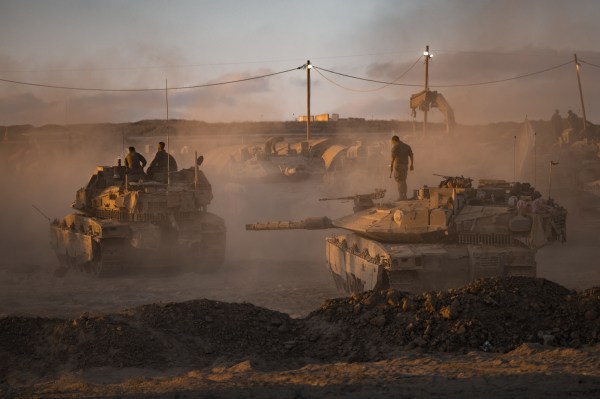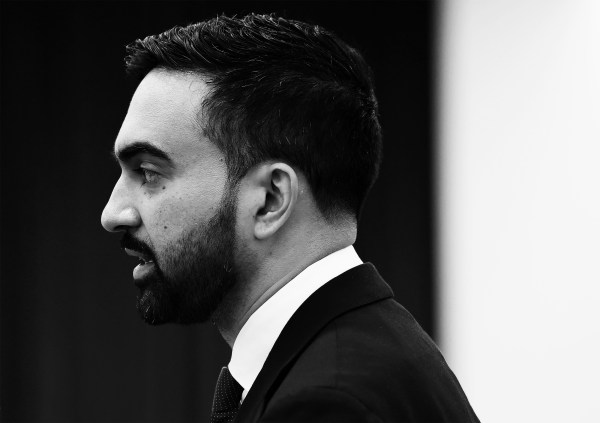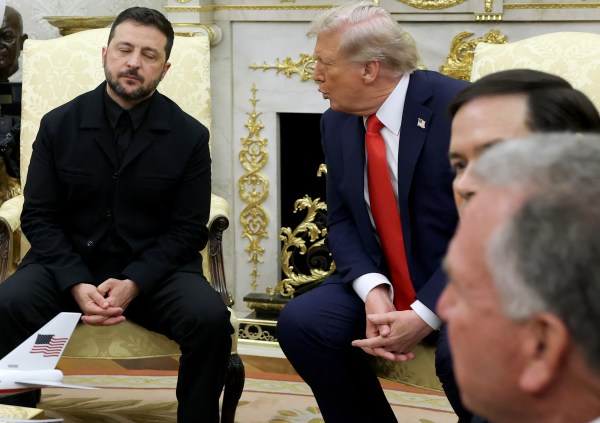The rioting caught Simon Hinton by surprise. “It started on Friday with a protest for George Floyd,” he says. “I don’t even think the cops were expecting things to explode.” But what began as a peaceful demonstration in Omaha, Nebraska, got out of control quickly: Suddenly, “almost 1,000 people were in the streets in a massive battle between cops and protesters,” Hinton says. “And from that point on through the rest of the night, it was just a mess.”
That’s more or less what Hinton, 25, had been hoping for. The self-professed revolutionary communist attended the protest with his comrades to “try to agitate things politically,” he tells me. And it worked: “It grew exponentially. Next thing you know, there’s like 700 to 1,000 people in the street, marching straight down Dodge Street.”
The rioters faced off against a wall of riot police for hours, even briefly attempting to construct a makeshift barricade in the middle of the street using drywall and plywood from a nearby dumpster. “It was just all out war at that point,” Hinton says. “I mean, cops just tear-gassing indiscriminately.”
The scene in Omaha was mirrored throughout the country. As thousands gathered to protest the killing of George Floyd by Minneapolis police, a wave of looting and violent rioting swept many major cities, overwhelming local police departments and resulting in 17 deaths. But there continues to be widespread disagreement over which groups bear primary responsibility for the chaos that accompanied peaceful protests. Many argue that the looters were low-level opportunists using the unrest as occasion to break into unprotected stores while law enforcement was distracted; others see a significant portion of deliberate violence that seemed to be explicitly political in nature.
The latter claim continues to be difficult to verify: The nature of the protest-related political violence remains murky, and fundamental questions about its perpetrators are still unanswered. But testimonies from purported agitators like Hinton, paired with reports from many major cities, seem to give credence to the suspicion that the destructive uprisings throughout the country were at least partially the handiwork of a radical political contingent at the fringes of recent protests: Antifa.
Antifa, a loose collection of far-left activists who describe themselves benignly as “anti-fascist” and are distinguished both by their outward-facing appearance and their disruptive tactics, have become the favorite bogeyman of the right.
President Trump went so far as to declare on Twitter that his administration would “be designating ANTIFA as a terrorist group” last week—provoking a flurry of speculation regarding the president’s legal authority to designate domestic terrorist groups—and Attorney General William Barr released a similar statement soon after, reading: “The violence instigated and carried out by Antifa and other similar groups in connection with the rioting is domestic terrorism and will be treated accordingly.” But it’s still unclear whether this violence stemmed from a coherently organized movement or a decentralized coalition of smaller militant groups.
It’s often difficult to discern the official, monolithic “Antifa” from smaller, disconnected organizations that adopt the group’s traditional appearance and tactics. Activists who associate themselves with Antifa usually dress in “black bloc”—clothed in black from head to toe with face-masks to conceal their individual identities—and are notorious for their propensity for violent confrontation in a variety of settings, most commonly on the margins of contemporary left-wing protest movements but also in direct conflict with right-wing and alt-right groups..
But beyond that, “it’s really not its own group at this point,” says Hinton, who regularly participates in local anti-fascist demonstrations. “Like, there’s no one group that really meets that definition. It’s largely just other militant leftist groups wearing black bloc. There’s so many people that just wear all black and masks to these things regardless, without any sort of affiliation with Antifa.”
There are some exceptions to this description: In cities like Portland, Oregon, where large numbers of Antifa activists regularly hold demonstrations with minimal resistance from the police, Antifa is a formal organization with a public website, leadership structure and network. “In places like Oregon, there’s a much larger presence and you can get hundreds of people to march together en masse,” Hinton acknowledges. Elsewhere, “that’s not really the situation.”
But regardless of the state of their organizing structure, the militants associated with Antifa or Antifa-adjacent leftist groups throughout the country all adhere to a set of uniformly identifiable ideological precepts, undergirded by a violent radicalism that sets them apart from more mainstream progressive movements. Most identify as either anarchists or communists and are united by a desire to overthrow the existing social order, despite lacking a centralized leadership structure. Although the tensions between the group’s anarchic and communistic elements are occasionally challenging, those doctrinal disputes are “long-term differences,” Hinton says. “Right now, they’re not important, because we’re just focused on pushing a unified anti-capitalist and revolutionary politic to the masses and getting more regular people to radicalize.”
The group’s participants are also united by an antipathy toward liberal notions of free speech and a deep skepticism of the normal democratic avenues for affecting political change. This persistent illiberalism is the foundation of Antifa’s militancy, which stems from the conviction that violent, extra-legal action is necessary to further their political goals. “You can’t condemn violence inherently. Sometimes we reach a point where it should be utilized,” says “Tashi,” a Toronto-based Antifa activist who asked that his real name not be used. “There’s a moral or ethical difference between the violence of a white supremacist and that of somebody who punches Richard Spencer. And I think that the problem with liberalism and liberal politics is that within the confinements of the law, within the confinements of our political discourse, those two things are equated. And that’s dangerous, to equate those two kinds of things.”
In the years since the group’s emergence on the national stage, they have used violence to disrupt events that adherents deem to be “fascist” or to contain otherwise intolerable ideas. In many ways, this is the raison d’être that unites the loose network of Antifa affiliates across the country: a militant commitment to preventing the far-right from gaining a platform. In his influential 2017 Anti-Fascist Handbook, Mark Bray writes: “Anti-fascists have concluded that since the future is unwritten, and fascism often emerges out of small, marginal groups, every fascist or white-supremacist group should be treated as if they could be Mussolini’s one hundred fasci, or the fifty-four members of the German Workers’ Party that provided Hitler’s first stepping stone.” And, Hinton adds, one of Antifa’s main goals is “to educate the public on how fascism is still really a threat. Because when you talk about fascists, a lot of people tend to think they don’t have any relevance, or they all died in the forties. But that’s really not the case. A lot of new groups like Identity Evropa and Patriot Front couch their fascism in a more moderate tone, but in reality, they’re all still white supremacists.”
As a result of this militant anti-fascism, many Antifa activists see classically liberal concepts of free speech as unacceptable. “More mainstream traditional concepts of protesting and protesting tactics are rooted in the idea that we must work within the consignments of the law,” says Tashi. “The perspective of people in Antifa is that the social order we live in and its false notions of free speech have maintained and reinforced structures of white supremacy. And we need to reactively make sure that [fascists] are not able to influence or otherwise participate in public discourse.”
The problem, however, is that many purported anti-fascists have expanded the definition of “fascism” to encapsulate a broad range of mainstream political philosophies that they find distasteful. Self-identified Antifa activists have subsequently begun to violently disrupt and shut down conservative speakers like Ben Shapiro whose speech they deem to be dangerous, and have even physically attacked attendees at a variety of fringe right-wing rallies and gatherings. As a result, Antifa has become the veritable bête noir of the American right. The president and his surrogates have even taken to using the group for campaign emails.
In contrast, progressives have generally been more skeptical that Antifa poses any real threat at all to the public order: Although some prominent Democratic leaders like Nancy Pelosi have felt obligated to distance themselves from the organization, many on the left have called it a trumped-up right-wing myth deployed either to energize the Republican base or distract from larger issues. Some have even gone so far as to actively defend the group, arguing that its nominal “we’re just opposed to fascism” position is analogous to American soldiers fighting Nazis in World War II. (“Biggest antifa rally in history,” reads a recent tweet from NPR’s Mara Liasson, attached to a map of the American invasion of Normandy).
But the events of the past few weeks should give pause to those who are tempted to soft-pedal the group’s character: Although it’s admittedly difficult to determine their membership in a singular organization, Antifa or Antifa-affiliated militants are clearly responsible for some portion of the recent violence in major metropolitan areas throughout the country. In this most recent endeavor, these activists have graduated from disrupting the occasional right-wing demonstration to a more dangerously violent level of criminal activity, often enabled by local progressive leadership that sees left-wing radicalism as a non-issue. This past week, for example, armed Antifa activists in Seattle chased law enforcement out of the Capitol Hill neighborhood—sending multiple officers to the hospital in the process—and established a lawless “autonomous zone,” empowered by a sympathetic Seattle City Council that is largely uninterested in supporting police efforts to reclaim the area. Multiple City Council members actively supported the activists’ efforts, with one—Kshama Sawant, a councilwoman from the Socialist Alternative Party—going so far as to travel to the hostage neighborhood and give encouraging speeches.
This disorder will likely persist if political leaders continue to refuse to take leftist militancy seriously. Antifa is hardly the clandestine terrorist organization that President Trump makes it out to be, but the group’s political goals, while often ideologically murky, promote violence and destruction. Riots “are a good thing,” says Hinton. “It’s a practical, material way of giving people experience in how to fight the state and showing that it’s possible. Rioting also serves a purpose in building a more militant consciousness, and demonstrating the need for revolt more generally, not just around these specific issues every once in a while.”
“I think it very quickly and very easily demonstrates what the two sides actually are, you know?” he adds. “Because when there’s a riot, the whole ‘well there’s some good cops, there’s some good businesses, blah blah blah,’ that goes out the window. There’s two sides, and two sides only.”
On at least one count, Hinton is right: Rioting and looting do serve to further polarize communities throughout America. Productive political discourse is made nearly impossible by mass lawlessness. For activists in the Antifa movement, this is precisely the point: The chaos caused by civic unrest drives our society one step closer to all-out war, which the radicals see as the precursor to revolution. But for those who eschew the wild-eyed utopianism of the revolutionaries and maintain a measured belief in our political system’s ability to correct its faults, the battles currently being waged in our streets are an alarming threat to the basic ideals of liberal democracy. Left-wing militants have little use for these ideals; this, of course, is only to be expected. But the apathetic, faint-hearted politicians who have allowed for this chaos should still know better.
Nate Hochman (@njhochman) is a summer Intercollegiate Studies Institute fellow for The Dispatch.
Photograph by Barry Chin/Boston Globe/Getty Images.






Please note that we at The Dispatch hold ourselves, our work, and our commenters to a higher standard than other places on the internet. We welcome comments that foster genuine debate or discussion—including comments critical of us or our work—but responses that include ad hominem attacks on fellow Dispatch members or are intended to stoke fear and anger may be moderated.
With your membership, you only have the ability to comment on The Morning Dispatch articles. Consider upgrading to join the conversation everywhere.